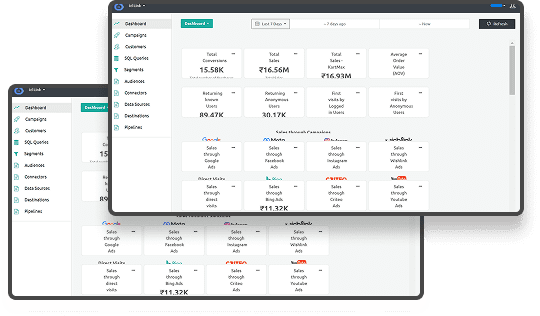Did you know businesses spend over $137 billion annually on PPC advertising worldwide? Ensuring every dollar generates a meaningful return is crucial with such significant investments.
Two critical metrics that help marketers measure and optimize their PPC campaigns are Advertising Cost of Sale (ACoS) and Return on Ad Spend (ROAS). These metrics provide valuable insights into campaign profitability, efficiency, and overall impact, empowering businesses to make informed decisions about their ad strategies.
In this blog, we’ll focus on two essential metrics—Advertising Cost of Sale (ACoS) and Return on Ad Spend (ROAS)—to help you measure and optimize the performance of your PPC campaigns effectively.
Let’s define the key metrics that drive successful PPC campaigns: ACoS and ROAS.
What are ACoS and ROAS?
ACoS and ROAS are two fundamental metrics used to measure the effectiveness of PPC campaigns.
- Advertising Cost of Sales (ACoS): ACoS calculates the percentage of your ad spend relative to the revenue generated from those ads. It is calculated using the formula:
ACoS=(Ad Spend/Revenue)×100
- Return on Ad Spend (ROAS): ROAS measures the revenue earned for every dollar spent on advertising. It is calculated using the formula:
ROAS=Revenue/Ad Spend
Understanding ACoS vs ROAS is crucial for assessing the profitability of your advertising campaigns and making informed budget allocation decisions.
For more insights on tracking and optimizing your digital properties, visit our Best Tools for Tracking Digital Properties blog.
Now that we understand what ACoS and ROAS are let’s explore why they are essential for evaluating and improving advertising performance.
Importance of ACoS and ROAS in Advertising
Measuring ACoS vs ROAS provides valuable insights into the efficiency and profitability of your PPC campaigns. Here's why these metrics matter:
- Performance Evaluation: Both ACoS and ROAS help you determine whether your campaigns are generating sufficient revenue to justify the ad spend.
- Budget Allocation: By analyzing these metrics, you can allocate your budget more effectively across different campaigns and channels.
- Campaign Optimization: Identifying high-performing and underperforming ads allows you to optimize your strategies for better results.
- Goal Alignment: These metrics ensure that your advertising efforts are aligned with your overall business goals, such as increasing sales or maximizing ROI.
Explore the significance of data-driven strategies in our Understanding Multi-Touch Attribution and Its Basics blog.
Understanding their importance is one thing, but knowing how to calculate ACoS and ROAS is critical for actionable insights.
Calculating ACoS and ROAS
Calculating ACoS vs ROAS is straightforward and essential for tracking your campaign performance.
- Calculating ACoS:
ACoS=(Ad Spend/Revenue)×100
Example: If you spent $200 on ads and generated $1000 in sales:
ACoS=(200/1000)×100 = 20%
- Calculating ROAS:
ROAS=Revenue/Ad Spend
Example:
ROAS=1000/200 = 5
This means you earned $5 for every $1 spent on ads.
Accurately calculating these metrics allows you to make data-driven decisions to enhance your marketing strategies.
Learn more about accurate data tracking in our How to Stay Ahead of Tag Errors with Proactive Monitoring blog.
Once you know how to calculate these metrics, the next step is to understand how they compare and complement each other.
Comparing ACoS and ROAS
Understanding the differences between ACoS vs ROAS is key to leveraging them effectively:
- Perspective:
- ACoS: Focuses on the cost relative to sales, expressed as a percentage.
- ROAS: Focuses on the revenue generated per dollar spent, expressed as a ratio.
- Interpretation:
- ACoS: Lower ACoS indicates higher efficiency, meaning less ad spend is required to generate revenue.
- ROAS: Higher ROAS indicates better performance, meaning more revenue is generated per dollar spent.
- Usage:
- ACoS: Often used to assess the profitability of individual campaigns or keywords.
- ROAS: Commonly used to evaluate overall campaign effectiveness and compare different marketing channels.
By analyzing ACoS vs ROAS, you can gain a comprehensive view of your campaign performance and make informed optimization decisions.
While these metrics provide valuable insights, several factors can influence their accuracy and effectiveness.
Factors Affecting ACoS and ROAS
Several factors influence ACoS vs ROAS, impacting the effectiveness of your PPC campaigns:
- Ad Quality and Relevance: High-quality, relevant ads tend to generate more clicks and conversions, improving ROAS and reducing ACoS.
- Targeting Accuracy: Precise targeting ensures your ads reach the right audience, enhancing conversion rates.
- Bid Strategy: Effective bid management can optimize ad placement and cost, affecting both ACoS and ROAS.
- Keyword Selection: Choosing the right keywords can increase ad visibility and conversion rates, positively impacting ROAS.
- Landing Page Experience: A well-designed landing page can improve conversion rates, thereby enhancing ROAS and reducing ACoS.
- Competition: High competition can drive up ad costs, affecting ACoS and potentially lowering ROAS.
- Seasonality: Seasonal trends can influence consumer behaviour and ad performance, impacting these metrics.
Understanding these factors allows you to adjust your strategies to optimize both ACoS vs ROAS effectively.
Discover how external factors influence your marketing efforts in our Understanding and Optimizing Conversion Funnels in Digital Marketing blog.
By recognizing the factors at play, you can focus on strategies to optimize your PPC campaigns using ACoS and ROAS.
Optimizing PPC Campaigns with ACoS and ROAS
Leveraging ACoS vs ROAS to optimize your PPC campaigns involves several strategies:
- Refine Targeting: Use precise audience targeting to ensure your ads reach the most relevant users, enhancing conversion rates.
- Improve Ad Quality: Create compelling, relevant ads that resonate with your audience to increase click-through and conversion rates.
- Optimize Bidding Strategies: Adjust your bids based on performance data to maximize ROAS and minimize ACoS.
- Keyword Optimization: Regularly review and update your keyword list to focus on high-performing keywords that drive better ROAS.
- Enhance Landing Pages: Ensure your landing pages are optimized for conversions, providing a seamless user experience.
- A/B Testing: Continuously test different ad variations to identify what works best for your audience.
- Monitor and Adjust: Regularly monitor your ACoS and ROAS metrics and adjust your strategies accordingly to maintain optimal performance.
Implementing these optimization techniques can significantly enhance your PPC campaign performance, driving better ROI.
For more tips on campaign optimization, visit our Guide to Real-Time Analytics for Successful Campaign Optimization blog.
To fully leverage these metrics, it’s important to understand the relationship between ACoS and ROAS and how they impact each other.
Interpreting the Relationship between ACoS and ROAS
Understanding the interplay between ACoS vs ROAS is crucial for making balanced marketing decisions:
- Inverse Relationship: Typically, as ACoS decreases, ROAS increases, and vice versa. A lower ACoS means you are spending less on advertising for the same amount of sales, thereby increasing ROAS.
- Balanced Approach: While aiming for a low ACoS is beneficial, it's essential to ensure that it doesn't come at the expense of ROAS. Striking the right balance ensures that your campaigns are both cost-effective and profitable.
- Strategic Decision-Making: By analyzing both metrics together, you can make more informed decisions about where to allocate your budget, which campaigns to scale, and which to adjust or discontinue.
Effectively interpreting ACoS vs ROAS helps you maintain a healthy balance between cost and revenue, ensuring sustainable growth for your PPC campaigns.
Learn how to balance different marketing metrics in our Cross-Channel Attribution Models blog.
Finally, let’s look at how Ingest Labs can help you achieve accurate and actionable ACoS and ROAS calculations to elevate your campaigns
How Ingest Labs Enhances ACoS and ROAS Calculation
Ingest Labs plays a crucial role in improving the accuracy and efficiency of ACoS (Advertising Cost of Sale) and ROAS (Return on Ad Spend) calculations for PPC campaigns. Here’s how their expertise can be integrated:
1. Accurate Conversion Tracking: Ingest Labs ensures precise conversion tracking by leveraging server-side tracking. This approach overcomes limitations such as ad blockers and cookie restrictions, capturing every conversion and providing reliable data for calculating ACoS and ROAS.
2. Unified Data from Multiple Platforms: For businesses running PPC campaigns on platforms like Google Ads, Amazon, and Facebook, data fragmentation can hinder performance analysis. Ingest IQ consolidates data from all platforms into one centralized system, enabling seamless ACoS and ROAS analysis across campaigns.
3. Enhanced Attribution Modeling: Effective calculation of ACoS and ROAS requires accurate attribution of user interactions. Ingest Labs provides advanced tracking that captures user journeys across channels and devices, ensuring your metrics reflect true campaign performance.
4. Privacy-Compliant Data Collection: Ingest Labs ensures that all data collected for PPC analytics is compliant with global privacy regulations like GDPR and CCPA. This enables businesses to confidently calculate ACoS and ROAS, maintaining accuracy and user trust.
5. Real-Time Insights: Real-time data is critical for optimizing PPC campaigns and improving ACoS and ROAS metrics. Ingest Labs enables real-time data streaming to analytics tools, ensuring businesses can make timely adjustments to maximize performance.
6. Scalable Solutions for Campaign Growth: As PPC campaigns grow in scale, data volume can become a challenge. Ingest Labs offers scalable server-side solutions that ensure tracking and analytics remain robust, even for large-scale campaigns.
Ingest Labs provides the foundation for precise and effective ACoS and ROAS calculations. By ensuring accurate, privacy-compliant, and real-time data collection, they empower businesses to optimize PPC campaigns and achieve better performance
Conclusion
Understanding and calculating ACoS (Advertising Cost of Sale) and ROAS (Return on Ad Spend) are essential for optimizing your PPC campaigns. These metrics provide a clear picture of how efficiently your ad spend translates into sales and revenue, empowering you to make data-driven decisions that maximize profitability.
By focusing on improving these metrics, businesses can allocate budgets more effectively, identify underperforming campaigns, and capitalize on the channels delivering the best results. Whether you're striving for a lower ACoS, a higher ROAS, or a perfect balance between the two, the key lies in accurate tracking and insightful analysis.
Partnering with a solution like Ingest Labs can further enhance your PPC strategy. With precise server-side tracking, unified data management, and privacy-compliant analytics, Ingest Labs ensures you have the reliable data needed to optimize your advertising efforts.
Ready to take your PPC campaigns to the next level? Contact us today to discover how Ingest Labs can optimize your PPC campaigns and transform your advertising outcomes.






